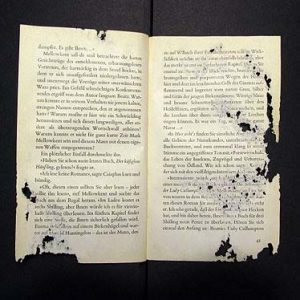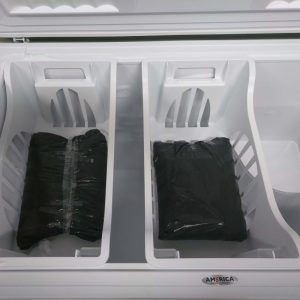Disclaimer: Content in the following blog post may be disturbing to bug lovers.
Recently I picked up a donation for the archives that caused me some concern. Before bringing the newly acquired collection into the stacks I noticed a silverfish at the bottom of the bankers box. Archival instincts taking over, I immediately crushed the insect.

Destruction after grazing of silverfish. Photo Credit: Micha L. Rieser (Wikipedia)
Panic is seldom a word heard in the archives profession. With my heartbeat rising, my mind immediately raced to the horror stories I heard about at archival conferences. Sweaty palms, I needed to address the situation and address it quickly. Perhaps the word panic is a bit melodramatic; but, it’s not every blog post that I get to exaggerate somewhat.
Silverfish – Lepisma Saccharina – will graze across records leaving a wake of destruction in their path. Okay, maybe not exactly a wake of destruction but they can multiple and precautions should be taken to keep their populations in control. In his book, “How to Recognize and Eliminate Silverfish, Beetles, Cockroaches, Moths, Termites, Rats and Mildew in Libraries and Archives,” Thomas A. Parker explains how Silverfish enter an institution.
“They lay eggs in the corrugations of cardboard boxes, one of their favorite areas for egg deposition. Although the adult silverfish may not feed directly on the cardboard, they very commonly feed on the glue that holds the cardboard box together. With every cardboard box coming into a library, a new load of silverfish and their eggs is bound to arrive. Upon hatching, depending on the conditions in which the box is stored, they may then roam widely to find a suitable food source.”
Alright everyone, Chill!
Obviously, it is nearly impossible to prevent silverfish and other pests from entering an archive. The best preventative solution is environmental control, cleanliness, and monitoring in the stacks. Nevertheless, records that have obviously been compromised should be addressed before the archivist places them in the same stacks as other records. One of the easiest and most effective ways to eliminate bugs and their eggs on paper material is by freezing the records.
Step one: Isolate the material. I kept the material in my truck while I consulted my archival pest management manuals.

Freezing records at the Chilliwack Museum and Archives. Photo credit: Tristan Evans (June 19, 2017)
Step two: Wrap the records in plastic or Ziploc bags tightly and seal them with water resistant tape to prevent condensation from forming.
Step three: Freeze the materials at a temperature of at least -20 C for 72 hours.
Step four: Remove the material and defrost as slowly as possible. Keep the records sealed for roughly three weeks and watch for holes in the plastic. If holes do appear, eggs within the compromised records may not have been killed during the freezing process and the hatched bugs may be attempting to escape by eating their way out.
Repeat as necessary.
When it comes to silverfish and other forms of pests my mind defaults to what Mr. Freeze eloquently said, “I’m afraid my condition has left me cold to your pleas of mercy.”

Comments are closed.